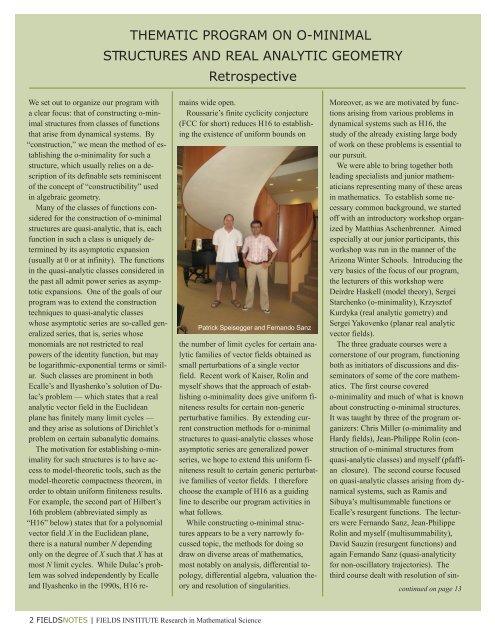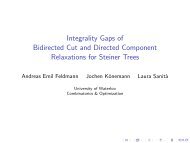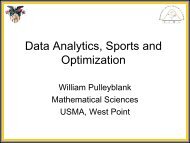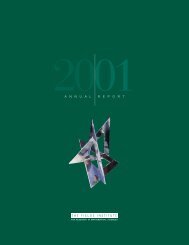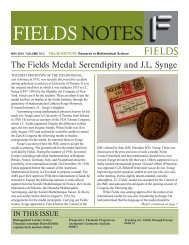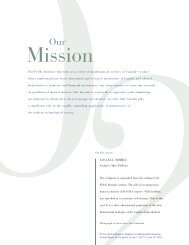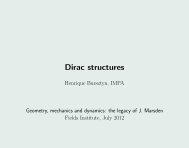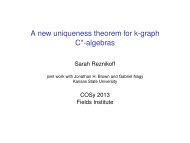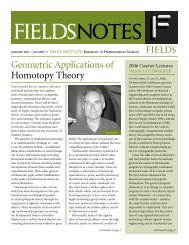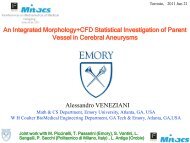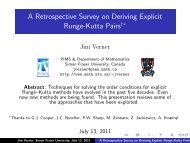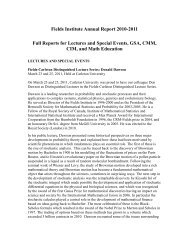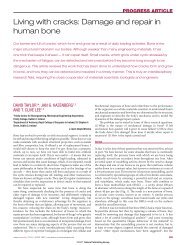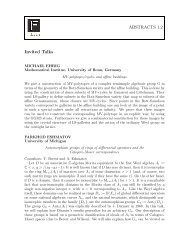Fields Notes, September 2009 - Fields Institute - University of Toronto
Fields Notes, September 2009 - Fields Institute - University of Toronto
Fields Notes, September 2009 - Fields Institute - University of Toronto
Create successful ePaper yourself
Turn your PDF publications into a flip-book with our unique Google optimized e-Paper software.
We set out to organize our program with<br />
a clear focus: that <strong>of</strong> constructing ominimal<br />
structures from classes <strong>of</strong> functions<br />
that arise from dynamical systems. By<br />
“construction,” we mean the method <strong>of</strong> establishing<br />
the ominimality for such a<br />
structure, which usually relies on a description<br />
<strong>of</strong> its definable sets reminiscent<br />
<strong>of</strong> the concept <strong>of</strong> “constructibility” used<br />
in algebraic geometry.<br />
Many <strong>of</strong> the classes <strong>of</strong> functions considered<br />
for the construction <strong>of</strong> ominimal<br />
structures are quasianalytic, that is, each<br />
function in such a class is uniquely determined<br />
by its asymptotic expansion<br />
(usually at 0 or at infinity). The functions<br />
in the quasianalytic classes considered in<br />
the past all admit power series as asymptotic<br />
expansions. One <strong>of</strong> the goals <strong>of</strong> our<br />
program was to extend the construction<br />
techniques to quasianalytic classes<br />
whose asymptotic series are socalled generalized<br />
series, that is, series whose<br />
monomials are not restricted to real<br />
powers <strong>of</strong> the identity function, but may<br />
be logarithmicexponential terms or similar.<br />
Such classes are prominent in both<br />
Ecalle’s and Ilyashenko’s solution <strong>of</strong> Dulac’s<br />
problem — which states that a real<br />
analytic vector field in the Euclidean<br />
plane has finitely many limit cycles —<br />
and they arise as solutions <strong>of</strong> Dirichlet’s<br />
problem on certain subanalytic domains.<br />
The motivation for establishing ominimality<br />
for such structures is to have access<br />
to modeltheoretic tools, such as the<br />
modeltheoretic compactness theorem, in<br />
order to obtain uniform finiteness results.<br />
For example, the second part <strong>of</strong> Hilbert’s<br />
16th problem (abbreviated simply as<br />
“H16” below) states that for a polynomial<br />
vector field X in the Euclidean plane,<br />
there is a natural number N depending<br />
only on the degree <strong>of</strong> X such that X has at<br />
most N limit cycles. While Dulac’s problem<br />
was solved independently by Ecalle<br />
and Ilyashenko in the 1990s, H16 re<br />
THEMATIC PROGRAM ON OMINIMAL<br />
STRUCTURES AND REAL ANALYTIC GEOMETRY<br />
Retrospective<br />
mains wide open.<br />
Roussarie’s finite cyclicity conjecture<br />
(FCC for short) reduces H16 to establishing<br />
the existence <strong>of</strong> uniform bounds on<br />
Patrick Speisegger and Fernando Sanz<br />
the number <strong>of</strong> limit cycles for certain analytic<br />
families <strong>of</strong> vector fields obtained as<br />
small perturbations <strong>of</strong> a single vector<br />
field. Recent work <strong>of</strong> Kaiser, Rolin and<br />
myself shows that the approach <strong>of</strong> establishing<br />
ominimality does give uniform finiteness<br />
results for certain nongeneric<br />
perturbative families. By extending current<br />
construction methods for ominimal<br />
structures to quasianalytic classes whose<br />
asymptotic series are generalized power<br />
series, we hope to extend this uniform finiteness<br />
result to certain generic perturbative<br />
families <strong>of</strong> vector fields. I therefore<br />
choose the example <strong>of</strong> H16 as a guiding<br />
line to describe our program activities in<br />
what follows.<br />
While constructing ominimal structures<br />
appears to be a very narrowly focussed<br />
topic, the methods for doing so<br />
draw on diverse areas <strong>of</strong> mathematics,<br />
most notably on analysis, differential topology,<br />
differential algebra, valuation theory<br />
and resolution <strong>of</strong> singularities.<br />
2 FIELDSNOTES | FIELDS INSTITUTE Research in Mathematical Science<br />
Moreover, as we are motivated by functions<br />
arising from various problems in<br />
dynamical systems such as H16, the<br />
study <strong>of</strong> the already existing large body<br />
<strong>of</strong> work on these problems is essential to<br />
our pursuit.<br />
We were able to bring together both<br />
leading specialists and junior mathematicians<br />
representing many <strong>of</strong> these areas<br />
in mathematics. To establish some necessary<br />
common background, we started<br />
<strong>of</strong>f with an introductory workshop organized<br />
by Matthias Aschenbrenner. Aimed<br />
especially at our junior participants, this<br />
workshop was run in the manner <strong>of</strong> the<br />
Arizona Winter Schools. Introducing the<br />
very basics <strong>of</strong> the focus <strong>of</strong> our program,<br />
the lecturers <strong>of</strong> this workshop were<br />
Deirdre Haskell (model theory), Sergei<br />
Starchenko (ominimality), Krzyszt<strong>of</strong><br />
Kurdyka (real analytic gometry) and<br />
Sergei Yakovenko (planar real analytic<br />
vector fields).<br />
The three graduate courses were a<br />
cornerstone <strong>of</strong> our program, functioning<br />
both as initiators <strong>of</strong> discussions and disseminators<br />
<strong>of</strong> some <strong>of</strong> the core mathematics.<br />
The first course covered<br />
ominimality and much <strong>of</strong> what is known<br />
about constructing ominimal structures.<br />
It was taught by three <strong>of</strong> the program organizers:<br />
Chris Miller (ominimality and<br />
Hardy fields), JeanPhilippe Rolin (construction<br />
<strong>of</strong> ominimal structures from<br />
quasianalytic classes) and myself (pfaffian<br />
closure). The second course focused<br />
on quasianalytic classes arising from dynamical<br />
systems, such as Ramis and<br />
Sibuya’s multisummable functions or<br />
Ecalle’s resurgent functions. The lecturers<br />
were Fernando Sanz, JeanPhilippe<br />
Rolin and myself (multisummability),<br />
David Sauzin (resurgent functions) and<br />
again Fernando Sanz (quasianalyticity<br />
for nonoscillatory trajectories). The<br />
third course dealt with resolution <strong>of</strong> sin<br />
continued on page 13


